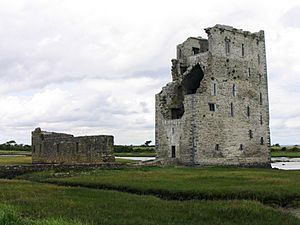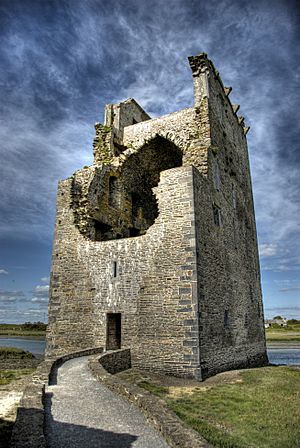Siege of Carrigafoyle Castle facts for kids
Quick facts for kids Siege of Carrigafoyle Castle |
|||||||
|---|---|---|---|---|---|---|---|
| Part of the Second Desmond Rebellion | |||||||
 Carrigafoyle Castle on the Southern shores of River Shannon,County Kerry,Ireland. |
|||||||
|
|||||||
| Belligerents | |||||||
| Irish Rebels |
|||||||
| Commanders and leaders | |||||||
| Sir William Pelham | Captain Julian | ||||||
| Strength | |||||||
| ~600 | 66 | ||||||
The siege of Carrigafoyle Castle was a big battle that happened around Easter in 1580. It took place near a town called Ballylongford in County Kerry, Ireland. The castle was right by the Shannon River. This battle was part of a larger fight called the Second Desmond Rebellion. The English Crown (the government of England) was fighting against Irish rebels led by Gerald FitzGerald, 14th Earl of Desmond. Some soldiers from Spain also helped the rebels defend the castle.
Contents
Why Carrigafoyle Castle Was Important
Carrigafoyle Castle was built in the 1490s by Conor Liath O'Connor-Kerry. People thought it was one of the strongest castles in Ireland. It was a tall tower house, common in the area of Munster. The castle stood on a rock in a small bay off the Shannon estuary. Its name comes from the Irish words Carraig an Phoill, meaning "rock of the hole."
The castle was known as "the guardian of the Shannon." This was because it controlled the shipping routes. These routes supplied the important trading city of Limerick, which was about 20 miles (32 km) upriver. The castle was well protected. It had a double defensive wall on the west and south sides. There was also a moat (a ditch filled with water) around it. The main tower itself was 86 feet (26 meters) tall.
The Battle Begins
During the rebellion, about 50 Irish fighters and 16 Spanish soldiers defended the castle. These Spanish soldiers had arrived the year before. There were also women and children inside. An Italian engineer named Captain Julian had been working to make the castle's defenses even stronger.
The English commander was Sir William Pelham. He marched through Munster with about 600 troops. He also had help from three large ships led by Sir William Winter. This was the biggest army ever seen in the west of Ireland at that time.
When the English arrived, they set up camp near the castle. Winter's ships anchored nearby and brought powerful cannons. These cannons were set up to fire at the castle walls.
The Attack on the Castle
The English cannons fired at the castle for two days, six hours each day. The cannons were very strong against stone walls. The ships also fired their cannons at the castle's side facing the sea.
On the first day, some English troops tried to cross to the castle's sea-wall. The defenders inside the castle fired at them and threw large rocks. The English tried to use ladders, but the Spanish soldiers pushed them away. The battle was very fierce. Sir William Pelham was even hit by a bouncing cannonball, but the attack continued.
On the second day, more English troops joined the fight from Winter's ships. The final attack focused on a part of the tower where the defenders were still holding out. After a few more shots, the huge west wall of the tower cracked and fell down. Many people inside were crushed. The survivors tried to escape through the shallow water. However, most were shot or killed by swords. The remaining survivors, including one woman, were taken back to the English camp and hanged. Captain Julian, the engineer, was hanged three days later.
What Happened Next
The fall of Carrigafoyle Castle was very important. Other rebel strongholds quickly gave up once they heard the news. The castle at Askeaton was abandoned. Its Spanish defenders even blew up its walls. Other rebel castles also fell soon after.
The rebels then started fighting a different kind of war, using surprise attacks. The English finally won the rebellion in 1583. This was when the Earl of Desmond was killed in the mountains near Tralee.
Carrigafoyle Castle was so badly damaged that it was never repaired. Its ruins still stand today. You can still see the effects of the powerful cannon fire on its walls.


